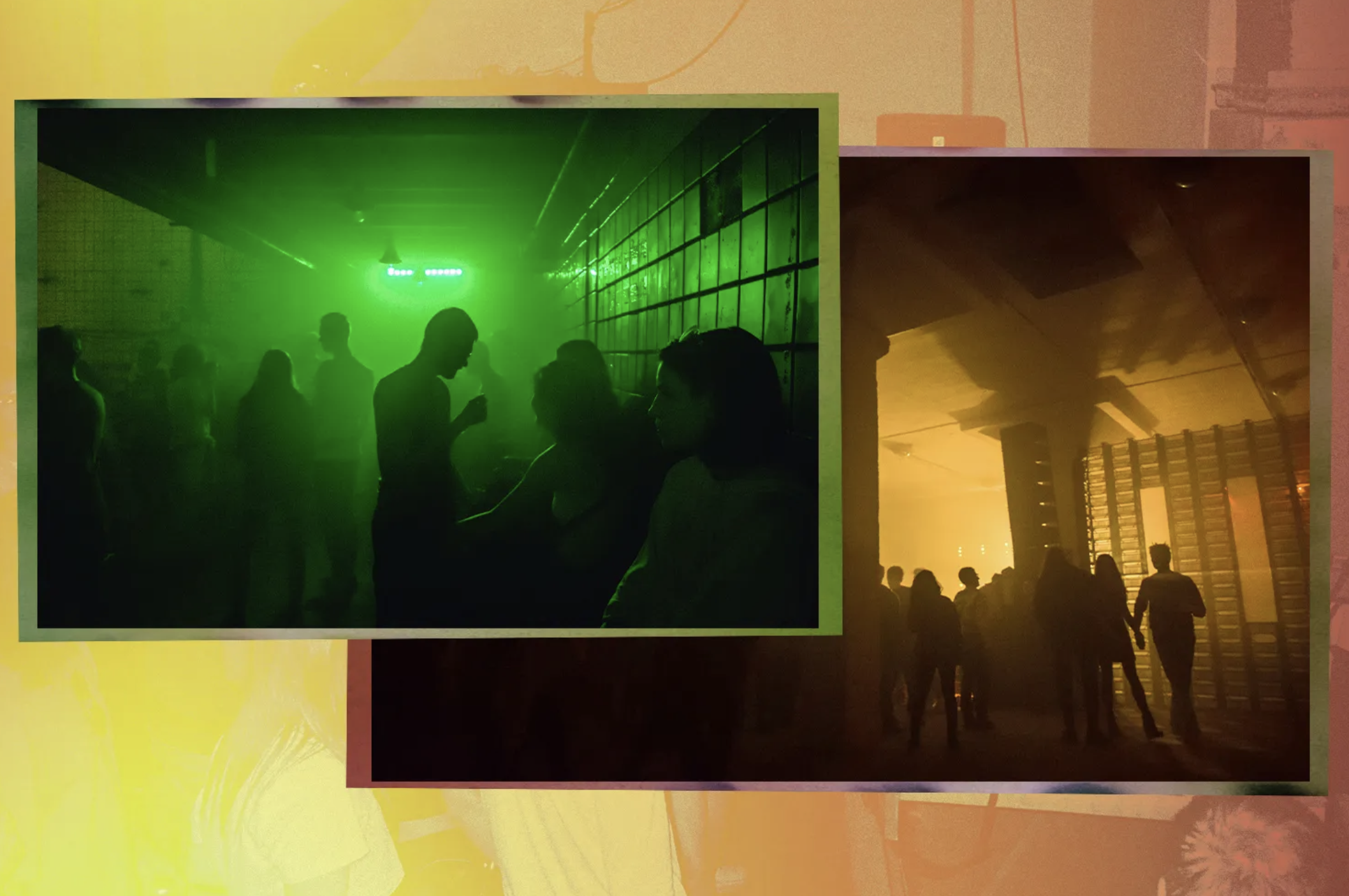How Independent Music Venues Are Surviving the Pandemic’s Long Tail
Graphic by Callum Abbott. Photos by Alexander Popov (inlay) and Maksim Zhashkevych (background) via Unsplash
After a year of COVID closures, live music made a halting but hard-won return in 2021. Big questions remain, but according to venue operators, there are reasons to be hopeful about the future.
By Marc Hogan
Velena Vego waited about 16 months for live music to return at the 40 Watt in Athens, Georgia, where she has been booking shows for more than three decades. Now, she’s still waiting for the storied college-rock institution, famous for nurturing hometown legends like R.E.M. and the B-52’s, to return to full steam. “This was a little slow in the fourth quarter,” the veteran talent booker says, “but I do believe that by next spring and the following fall, we’re going to see everybody coming through because they’re going to feel more comfortable.” She pauses. “Well, we hope so, right?”
The 40 Watt was lucky in many respects. After more than a year of agonizing uncertainty, the club was among the roughly 4,800 venues and promoters to receive potentially business-saving funding under the Save Our Stages Act, according to data from the federal government’s Small Business Administration. Since reopening in August, the venue’s Christmas light-strewn room has hosted sold-out shows for artists from Athens local Kishi Bashi to Philadelphia’s Alex G, with masks and proof of vaccination required. In March, Nashville indie-rock singer-songwriter Soccer Mommy is scheduled to kick off her 2021 tour here. “I’m just getting more optimistic,” Vego says.
With new tours being announced with regularity, some independent venues and promoters finally see the light at the end of the tunnel. Although an untold number of beloved spaces are permanently shuttered, the federal government has at long last disbursed $13 billion (of a promised $16 billion) in grant money to venues and other cultural institutions that have struggled to pay their bills during the global pandemic. And while fears about new COVID-19 variants such as Omicron persist, about 60 percent of Americans are now vaccinated. Laws and public attitudes about vaccine and mask enforcement vary from state to state, but in general, they seem to have done their job: allow for the reasonably safe return of live music.
“Everybody is feeling cautious and hopeful for 2022. It’s been an emotional ride,” says Audrey Fix Schaefer, head of communications at the National Independent Venue Association. “It’s a bit of a holdover sensation, of remembering we’re not done with this yet, but we’re closer every day.”
NIVA, an advocacy group of more than 3,000 venues, festivals, and promoters that formed in the early weeks of the pandemic, succeeded by the end of 2020 in getting Congress to incorporate the Save Our Stages Act into December’s COVID stimulus package, earmarking $16 billion in relief for venues that were forced to shutter. The process of actually putting money in venue operators’ hands this year turned out to be almost as torturous as enacting legislation, with NVA and other organizations blaming the SBA for “errors and delays” that meant only 90 businesses had received grant money as of early June 2021. But the situation has recently improved. According to the SBA, it had reviewed all of the initial applications out of 17,644 overall by mid-December.
Still, there are challenges. Audiences still have their reservations about COVID, which can pose a problem for venues even after tickets are purchased. Artists generally take a large share of ticket revenue, with venues relying on food and drinks sales to turn a profit. Schaefer has observed a jump across the industry in the percentage of ticket buyers who don’t show up to the concert—and thus don’t spend money at the bar—from about five to eight percent before COVID to 20 to 40 percent more recently. “If all those bodies aren’t walking through in order to consume those things, you’ll likely have about 30 percent less revenue.” Schaefer says. “That has been a pinch.”
Big Ears Festival, which takes place indoors across a dozen different venues in Knoxville, scrapped plans for its March 2020 event on the heels of SXSW’s cancellation, as the realities of the pandemic began to set in for most Americans. Organizers soon realized that March 2021 wouldn’t be feasible either and ultimately postponed for another year. In the meantime, they held streaming events, and more recently, began hosting smaller concerts outdoors and at a local church. In September, Big Ears announced the lineup for its March 2022 event, with a typically adventurous list of performers led by John Zorn, Moses Sumney, Meredith Monk, Sparks, Kim Gordon, Animal Collective, Yves Tumor, and Low. “The path seems a lot clearer now than it certainly did a year ago,” says Ashley Capps, the festival’s founder.
As a nonprofit, Big Ears depends on donors and secured funding through Save Our Stages. “I can’t overestimate how helpful that has been in enabling us to not act out of desperation but to come back in a bold way,” Capps says. Plans are already in the works for 2023.
Outdoor events had a better shot this year, especially given the lack of competition from movie theaters or indoor performing arts facilities in many regions. Chris Zacher, executive director of the nonprofit Levitt Pavilion Denver, sounds almost sheepish about his space’s successes in 2021. “For two months, my venue and Red Rocks were the only venues open,” Zacher says. Despite a cap on attendance at 7,500 at a venue that usually seats 20,000, Zacher says Levitt Pavilion Denver’s 2021 ticket sales and attendance were triple anything the nearly decade-old venue had seen before. “I had a banner year,” Zacher continues. “I feel for all my brothers and sisters across the U.S., these clubs that just really haven’t been able to get going.”
Zacher is measured about how his venue will fare as other spaces reopen in 2022, but he’s less guarded in his assessment of how the industry, in general, might fare next year. One way to judge is by the number of “holds”—that is, tentative notices that an artist would like to perform on an available date—on the books at any given venue. Zacher can’t recall seeing so many holds, so far in advance, in his 20 years in the industry. “It’s insane how many artists are going to go out next year,” he said. According to Vego, the 40 Watt also has an abundance of 2022 holds from national acts.
With open air at a premium amid concerns about the pandemic, some outdoor venues found themselves booked for more types of events than just music. Shahida Mausi, whose company runs Detroit’s 6,000-capacity Aretha Franklin Amphitheater, describes her venue’s reopening as “wonderfully crazy.” Instead of the usual 40 to 45 events, the Aretha hosted 73, including concerts—like a particularly memorable Phoebe Bridgers set backdropped by a dramatic lightning storm—graduations, funerals, and even a policy conference. “The crazy part is that nobody was coming to work,” Mausi added with a laugh. “It’s a good thing I have a big family!”
As with the broader economy, a rebound in live music activity has made it tough for venues to hire enough workers. “There’s a labor shortage with touring and festival personnel, which has been causing problems for certain events,” says concert insurance veteran Peter Tempkins, a managing director at Hub International. The lack of staffing extends from local crews and security to bus drivers and truck drivers, he says. Some who used to work in the industry have moved to different locations, and others have taken on other professions, perhaps even adjusting to a life of not going to bed at 3 or 4 in the morning, says NIVA’s Schaefer. “But the other thing is, this is in so many people’s blood.” At the 40 Watt, with a mixture of new hires and returning veterans, Vego expects to have enough staff in place for a series of homecoming shows by Drive-By Truckers in January.
Once basic requirements like safety and staffing are met, music venues at their best offer spaces for communal creative expression—and even, perhaps, transcendence. One recent night at Le Poisson Rouge, a 700-capacity venue in Manhattan’s West Village, Canadian indie-rock veterans Stars opened their set with the title track from their 2007 album In Our Bedroom After the War. For fans who may have been attending their first concert since March 2020, lead singer Torquil Campbell belted out decade-old lyrics that nonetheless captured the charge of the occasion: “All the living are dead, and the dead are all living/The war is over and we are beginning.” “It was just a very cathartic thing,” recalls LPR co-founder David Handler. “They were so grateful, and it was so obvious, and everybody was so happy to be there. There’s so much we’ve all lost collectively and individually that I hope we all have a newfound appreciation for our fundamental need to be together.”
On the experimental fringes, the ritual of the concert itself looks ripe for an overhaul. “If we were to talk in 2025, I get the sense that we would be able to see from that distance that we’re going through this period where we’re redefining what it means to engage in events,” says Andre Perry, co-founder of Mission Creek Festival in Iowa City. Perry isn’t referring, necessarily, to the virtual concerts that proliferated during the past two years but to in-person events that command an audience’s attention in a way that’s distinct from the traditional bar or theater. He points to a recent Angel Bat Dawid performance in a local vegan restaurant with limited attendance: “It focused the audience and made for 50 people who really wanted to engage in artistic experience that they might be totally taking a chance on.” “I’m not saying the code has been cracked,” Perry says, acknowledging with a laugh that these sorts of shows may not be financially sustainable. “But I think the experiences are becoming more curated in our behavior and expectations. We’re relearning together as presenters, promoters, audiences, and artists.”
Independent venues face other headwinds going into next year, not least among them the corporate behemoths that have dominated their industry since long before COVID hit. In 2019, Live Nation-promoted shows accounted for about 60 percent of global ticket revenue for live music events, followed by AEG at roughly 30 percent. That market clout might help explain why Live Nation’s stock was hitting all-time highs even before the widespread return of live music, and why its share price is even higher now despite the deadly catastrophe at Travis Scott’s Live Nation-affiliated Astroworld festival. Credit where it’s due, though: Live Nation and AEG were early champions of requiring vaccinations or negative COVID tests for live music attendees.
For independent venue operators in communities around the country, being able to open their doors again to touring artists has itself been a hard-fought accomplishment. “To see all of the people coming back together, celebrating,” Levitt Pavilion Denver’s Zacher says, “I don’t think you can beat that.”

